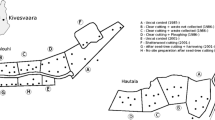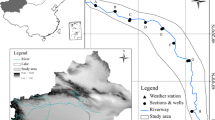Abstract
The unbridled development and use of water resources in the Tarim River basin over the last 50 years have led to a serious degradation of soil (>12×103 km2 of land desertified between the 1960s and 1990s) and water quality (rise in maximum salinity was from 1.3 g l−1 in 1960, to 4.0 g l−1 in 1981–1984, and to 7.8 g l−1 in 1998). Approximately 300 km of the lower reaches of the river course dried up between the 1950s and 1970s, seriously altering the downstream hydrological processes (a 4–6 m drop in groundwater levels from the 1960s to the 1980s, and 0.2 m yr−1 thereafter) and ecosystems (67% and 50% decrease (1958–1978) in Populus euphratica forest acreage and biomass, respectively). Between the 1950s and 1990s, 3820 km2 of P. euphratica forest and 200 km2 of shrub- and grassland were lost in the lower reaches of the Tarim River. In this study, based on estimates of soil organic carbon in desertified lands, it has been found that in the last 30 years (1970–2000), approximately 112 Tg of organic carbon (28% originating in the 0–1.0 m soil profile) has been released into the atmosphere as a result of soil degradation in the Tarim River basin. Intensive anthropogenic disturbance has been one of the foremost factors leading to the deterioration of water resources in this region. The key to solving these problems is to enhance the scientific and technical level of monitoring, management, and restoration of water resources and associated water and soil components of local ecosystems.




Similar content being viewed by others
References
Chen JQ, Xia J (1999) Facing the challenge: barriers to sustainable water resources development in China. Hydrol Sci J 44(4):507–510
Ding WW (1989) The observations and studies of atmospheric ozone in Beijing and Kuning in China. In: Bojkov RD, Fabian P (eds) Ozone in the atmosphere. A Deepak Publishing, Hampton VA
Edmonds RL (1994) Pattern of China’s lost harmony: a survey of the county’s environmental degradation and protection. Routledge, London
Feng Q, Cheng GD (1998) Current situation, problem and rational utilization of water resources in arid north-western China. J Arid Environ 40:373–382
Feng Q, Cheng GD, Mikami MS (1999) Water resources in China: problems and countermeasures. Ambio 28:202–203
Feng Q, Cheng GD, Masao MK (2000) Trends of water resource development and utilization in arid north-western China. Environ Geol 39(8):831–832
Feng Q, Cheng GD, Endo KN (2001a) Water content variations and respective ecosystems of sandy land in China. Environ Geol 40:1075–1083
Feng Q, Cheng GD, Endo KH (2001b) Carbon storage in desertified lands: a case study from north China. GeoJournal 51:181–189
Feng Q, Cheng GD, Mikami MS (2001c) The carbon cycle of sandy lands in China and its global significance. Climatic Change 48:535–549
Frederick KD (1994) Long term water costs. In: Dudu S, Patrick R (eds) Water: our next crisis. Proceedings of the fifth national conference on environmental issues. Academy of Natural Sciences, Philadelphia
Li X, Yang D (2001) The efficiency of utilization of water resources and ecological loss in Tarim river basin. J Glaciol Geocryol 24(4):328–331
Liu YS, Wu CJ (2002) Situation of land–water resources and analysis of sustainable food security in China. J Nat Res 17(3):270–275
Liu YS, Jay G, Yang FA (2003) Holistic approach towards assessment of severity of land degradation along the Great Wall in Northern Shaanxi Province, China. Environ Monitor Assess 82(2):187–202
Strzepek KM, Yates DN, Elquosy DE (1996) Vulnerability assessment of water resources in Egypt to climate change in the Nile Basin. Climate Res 6:89–95
Survey reports of the Chinese Academy of Sciences Investigation Team (1965) Ground water resources in Xinjiang Autonomous Prefecture. Science Press, Beijing, pp 123–159
Tang QC, Qu YG (1992) Water resources and hydrology in arid region of China. Science Press, Beijing, pp 45–89
Viney NR, Sivapalan M (1996) The hydrological response of catchments to simulated changes in climate. Ecol Model 86:189–193
Wang S, Wang Y, Wang J, Mao Y, Shen Y (2003) Climate, hydrology variation and its significance in the recent 40-years in Tarim River basin. J Glaciol Geocryol 25(3):315–320
Wu SY (1992) Tarim basin heat and moisture transportation research-evaporation and its correlativity (In Chinese). Marine Publishing House, Beijing, p 153
Xia J, Takeuchi K (1999) Introduction to special issue on barriers to sustainable management of water quantity and quality. Hydrol Sci J 44(4):503–506
Xinjiang Geography Research Institute (1995) Research resources, environment and oasis in arid land (In Chinese). Sciences Press, Beijing, pp 109–113
Xun Y, Hu Y, Ma Y (2001) The effecting to ecoenvironment of development of the lower river basin of Tarim and the countermeasure for rebuilt and rehabilitation this area. Arid Land Geogr 24(4):342–345
Yang LP (1981) Water resources in Xinjiang and its utilization. Xinjiang Peoples’ Publishing House, Urumqi, pp 58–62
Zhou X, Li C (1990) The environment change of green corridor in the lower reach of Tarim River. In: Research on resource, environment and remote sensing in Tarim river. Scientific and Technology Press, pp 50–55
Acknowledgements
This research was supported by a grant from the Hundred Talent Scholar Foundation (2003401), Key Project KZCX1-09-03, KZCX3-SW-329, and KZCX1-10-06 of the Chinese Academy of Sciences.
Author information
Authors and Affiliations
Corresponding author
Rights and permissions
About this article
Cite this article
Qi, F., Wei, L., Jianhua, S. et al. Environmental effects of water resource development and use in the Tarim River basin of northwestern China. Environ Geol 48, 202–210 (2005). https://doi.org/10.1007/s00254-005-1288-0
Received:
Accepted:
Published:
Issue Date:
DOI: https://doi.org/10.1007/s00254-005-1288-0




